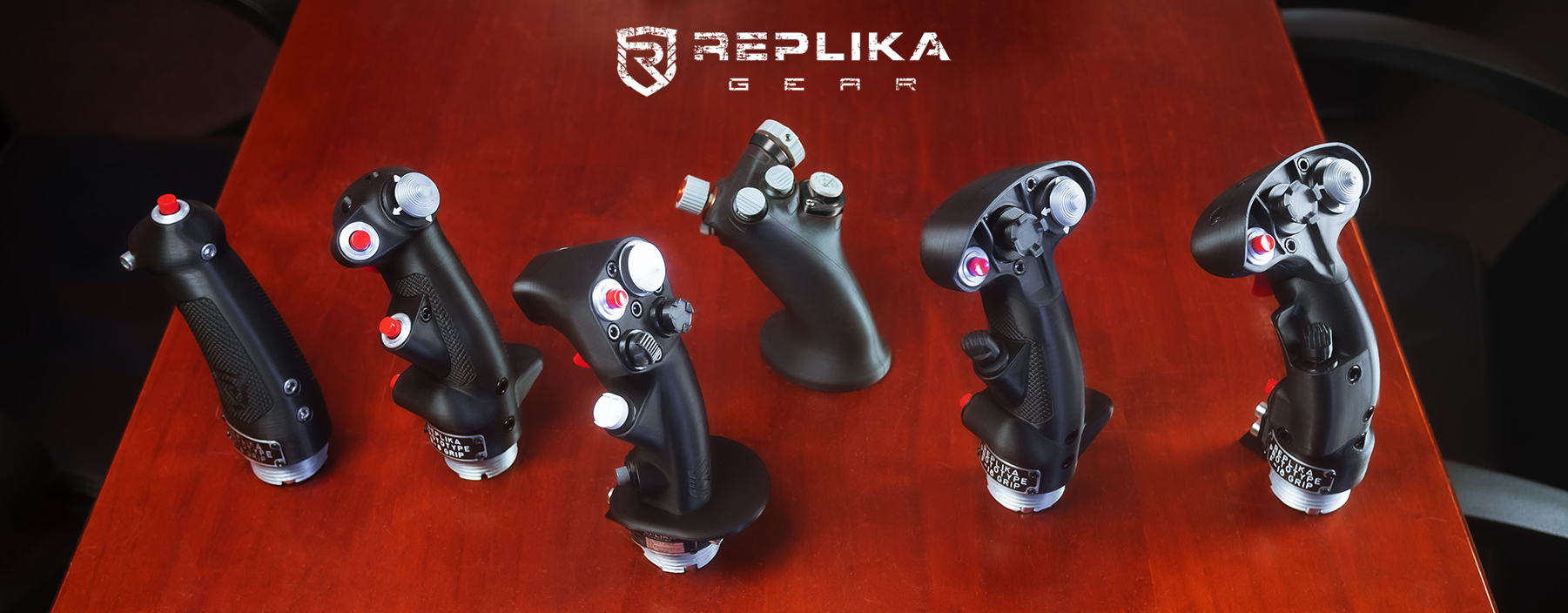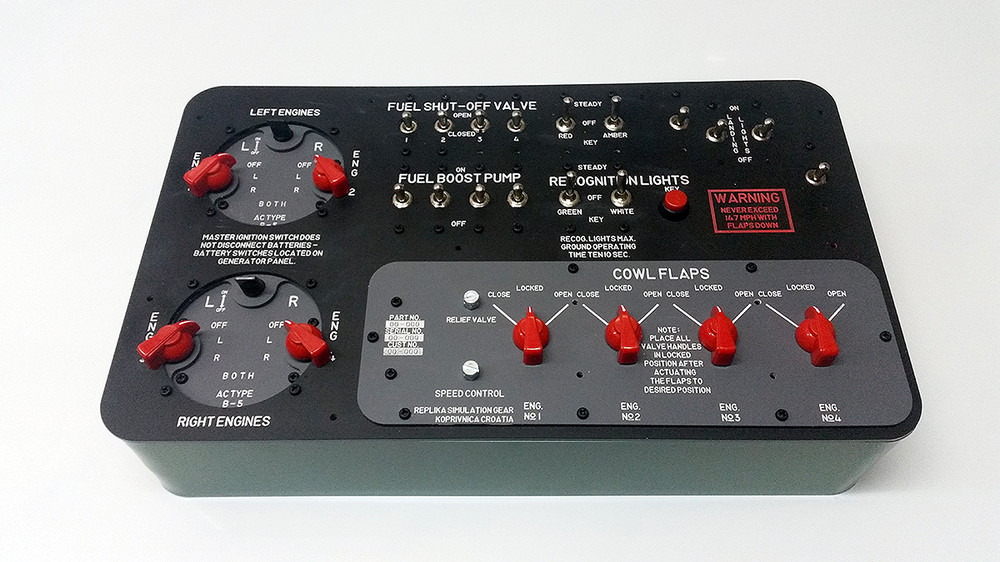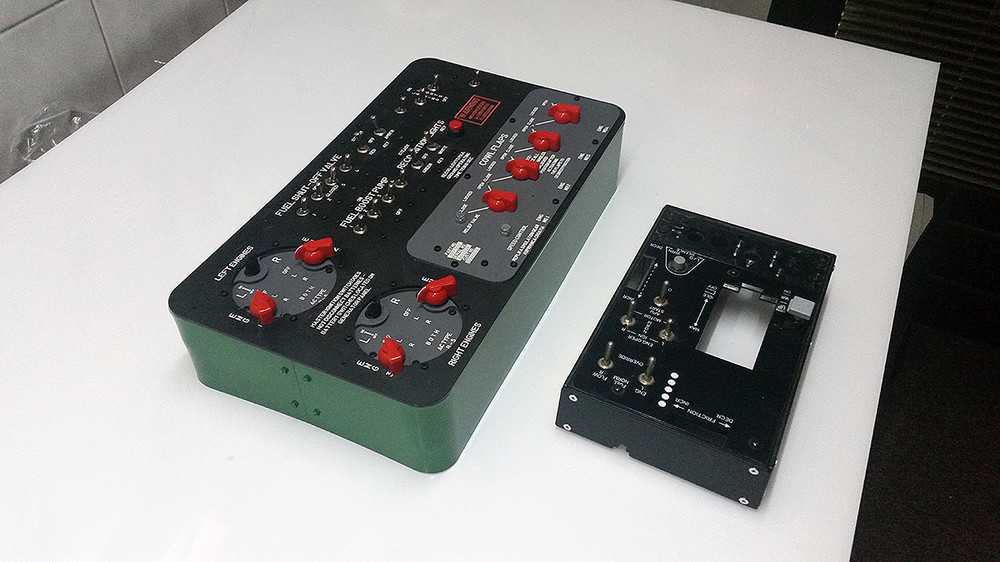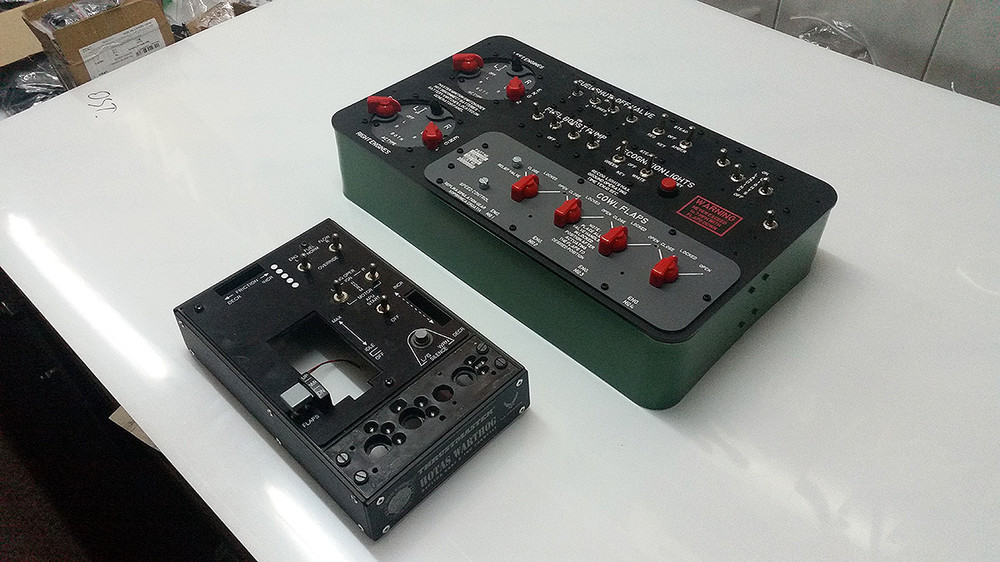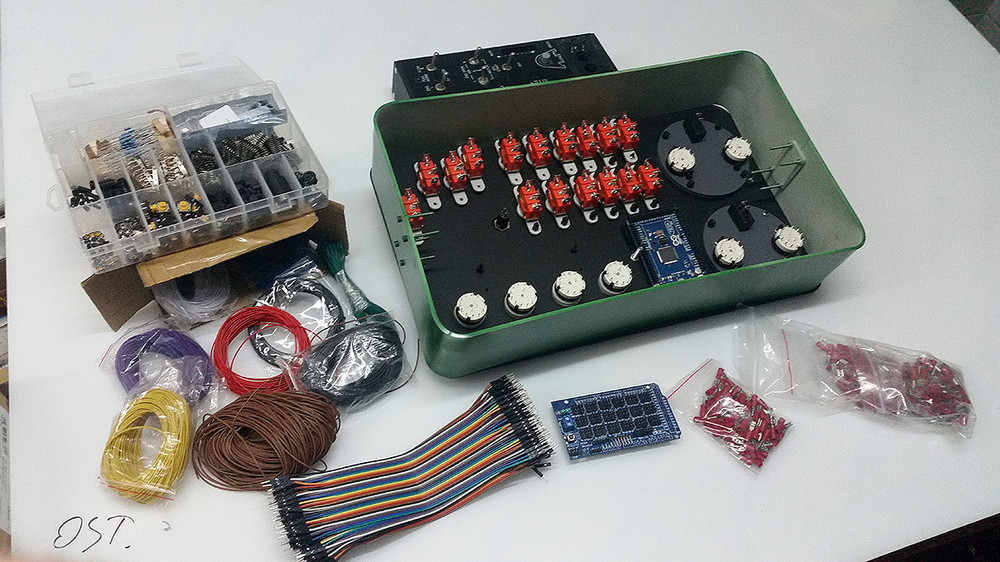-
Posts
791 -
Joined
-
Last visited
-
Days Won
4
Content Type
Profiles
Forums
Events
Everything posted by hegykc
-
That's just to show my engineering skillz :) I also managed to loose a single button cap and placed all the dual rocker buttons upside down.
-
I divided my prototyping into 3 levels, by order of complexity. 1) Laser cutting, bending and forming 2) CNC milling 3) 3D printing Head tracking units goes under phase 2), which I will start next month. I will gladly take your apologies when I release more products in the first opening month, then all the small manufacturers released combined since, ever ;) This week's prototype: Working, stand alone CDU along with automated, computer controlled tools and machinery to manufacture it in hundreds and thousands if needed. Coming up are panels, mechanical $10 instruments, MFCD's etc. Spring mod is still priority No.1 and will be available soon. Save Save
-
Spring mod is going through some (I hope) last modifications. Working CDU and UFC with glare shield videos coming up next week. Maybe even this Friday. Due to the progress I made with CDU while waiting on custom springs, A-10 left and right panel modules have moved up in priority.
-
Only small details today: toggle switch connector bar, and toggle safety guards found on modern jets too. Led push-to-check lamp found in WWII props and Korean era jets: And again, this is not about making one bar, guard or lamp. Anyone can make a 3d model and have it 3d printed on Shapeways for 25$. This is about designing it in such way, and developing the tools to manufacture each of these for 0.05$. And these are done. The goal is to not have a small part more expensive than a 1$ to make and takes no longer than a minute to manufacture (including paint and engraving), and not a panel more expensive than 5$ to make and takes no longer than 5 minutes to manufacture (including paint and engraving). Goal achieved. The same will be done for more modern instruments with digit displays, digit counters and 3d artificial horizons. This one is going under the knife sometimes this week. B-17 front panel with mechanical instruments. A test bed for FSX/Prepar3d platform. B-17 because it has curved shapes on the panel boxes, it has single pointer, dual pointer and triple pointer instruments. Push buttons, 2-way and 3-way toggles both latching and momentary, safety guards, connector bars and safety bars. Potentiates and rotary selectors, led mounts and led lamps etc.. Basically it has everything you can imagine in a WWII cockpit. This way I can develop most mechanical stuff in one pit, and just use the components on the rest of them. Also after I'm done, I can send it to FSX/Prepar3d crowd so they can work on interfacing it while I prototype DCS WWII fighters.
-
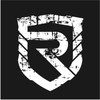
You want how much for a switch?!
hegykc replied to Braeden108's topic in PC Hardware and Related Software
Digikey also sels plain on-off toggles like the ones on the TM Warthog for 5$, when they are 0.50$ from china. Mini stuff like tactile pushbuttons, basic crimps and connectors for 0.5$ when they are 0.02$ from china. That's 10-20 times more expensive. Because they offer 1 piece minimum quantity. So I guess the switch costs much less if you order 1.000+ from the manufacturer, and the military gets it for a few $$$ when they order 100.000 units. Which is not that bad since the switches need to be dust proof, moisture proof, temperature proof etc... And you don't need that even if you want to be 100% realistic in your simpit. What do you care if your 0.50$ toggle switch would freeze up in case of canopy failure at 30.000 feet? Or would short out in case of defog failure and moisture build up? You just need it to look the part and function like the real one. -
Every lever, switch and instrument that's in the huey cockpit, so yes, collective base too.
-
Sure, I'll get in on this :thumbup: Huey collective enclosure: If you can, measure it, looking from top down, So I can correct my model if needed. Also the main instrument panel, with instrument positions. I know the instrument dimensions themselves. And the central panels basic dimensions so I can get them to correct dzus-rail dimensions. I will be protoyping needle instruments soon, and stuff like artificial horizon after that. Everything I prototype is made to be manufactured and sold eventually, if you're ok with that. You get on the "money no good here" list of course. Someone else will have to tackle interfacing all of this with DCS-bios and DCS.
-
Still waiting on the springs for the spring mod, due to the vacation season. And by "waiting" I mean working. Today's prototype: UH-1 Huey collective enclosure (missing some details). This is a perfect example of why I prioritized this type of manufacturing. It took me 2 hours to design it, along with the tools and jigs needed for bending and forming, and I'm getting better and faster each day. This unit is manufactured in 5 minutes, and assembled in another 5. That's 10 minutes, from zero to what you see in the picture. So I can design all the DCS collective enclosures in a day, manufacture a few hundred of each in another day, in advance on my own dime, and box them up and stock them for immediate shipping upon purchase. No matter how rare the DCS module is and how low the sales will be. That means it doesn't have to cost a few hundred dollars per unit, this could be a $30 part in my shop, once everything is setup and there's a 100 other products in the shop . I'm not stopping here though, it will have a base (with replaceable collective grips) and working force trim system. So that's what I'm all about. Not selling things cheap, but making them cheap. And fast. Drive that development and manufacturing cost into the god damn ground. In case anyone needs a huey, gazelle, Black Shark or Mi-8 standalone collective grip for their DIY project right now, let me know, email is in my profile. I will be prototyping all of them next week. Save
-
Warthog slew replacement is out for now. Can't connect it to the throttle pcb so you would need to route the wires out and make an enclosure for an arduino etc... It would be simpler to make a whole new throttle unit. I didn't get the custom springs for the spring mod last week because of the vacation season and holidays, so while I wait, I prototype panel related things. Grips need a whole bunch of stuff first: pcb's, custom push buttons, more 3d printers etc. So this takes priority because I need something simple that will sell while I spend a few months prototyping the grips.
-
The spring mod, very soon. It's just a matter of picking out the spring sets that will come along with it. It's vacation season over here, many of my suppliers are not working, plus we had a couple of national holidays this month so I lost some time. Still, it's just around the corner. Head tracker goes into prototyping the moment spring mod goes into sales. All the cutting, bending/forming, engraving and milling I do on these panels will be used on the head tracker too, so all the manufacturing will already be setup. Today's prototypes: Engraved brushed aluminum name plates (not printed stickers) I will use these a lot, both in replica cockpits and on my generic panels/throttles/joysticks. They are not stickers, but 1mm thick, matt black plastic with brushed aluminum finish and will be secured with screws just like the real things. And they're all designed in parametric cad, no corel/photoshop eyeballing stuff, everything according to NAA blueprints: Save
-
You guys are talking about two different groups. First one voicing their concerns and constructive criticism, and the second just being sarcastic. I welcome and address the first and ignore the second, you should too :)
-
Milan's controller for joystick base and throttles, that's for sure. Here it might be overkill, it might be perfect. I' curious to see how many buttons/toggles/rotaries/pots arduinos can handle. I'm not worried about firmware. There are dozens and dozens of talented programers here, and out there. Unfortunately there's no one doing the large scale work regarding hardware. That's the bottleneck. When I finish ironing out small details, I'll be able to turn out thousands of these panels per week, or hundreds per day, or dozens per hour. Whatever, It all just translates into much cheaper per unit. And I'm sure a lot of programmers will pitch in to make them come to life, once that bottleneck is gone, snowball effect. Bare minimum for now is arduino plus mmjoy or something like that. Sorry, misunderstanding. Like I said, not easy to put this into words. When I get actual measurements, make some videos, it'll be a much smoother communication. That would be an epic end to this thread :D I can't wait to retire this chit-chat monster and open threads as certain cockpits get done. The plan is to set up custom machinery to make everything, either in large quantities if there's a need, or small quantities quickly if there's not. By the time I get to Airbus, you won't need a worthog. It won't be soon though. Save
-
Today's prototype: B-17 autopilot panel. Wrong size knobs plus a few details missing. Save
-
Yes, July and August pictures are real physical prototypes. And all further pics else will be real. Unless just to show what's coming here and there. These are even functional "customer-ready" units. The grip photo was a mockup non-functional unit, so I guess you can still call that one vaporware, but not for long. All the toggle switches are the same as Warthog throttle ones, so a heavy industrial click. All the rotary selectors also. Only "problem" are the simple push-buttons, they have no "click" feedback nor a heavy spring so they're the only thing that feels "cheap" for now. Oh and the off-the-shelf stand-in knobs one might say, but I really like them for WWII stuff. Replica knobs will be 3d printed later on. Also I'll be doing my own push buttons, but that requires custom pcb's, custom mounting casings, and custom springs. But there are only a few push buttons on every 100 toggle/rotary inputs, so very few. I think there's 1 push button in the B-17 cockpit, and maybe 3 in P-51. I'm talking about the classic round buttons. Off-the-shelf buttons for CDU and MFCD are different kind and are ok. Right now the panels are 99%. The custom, industrial grade push buttons would bring it to 100%, but that 1% increase is going to cost more then all the panel prototyping put together. So for now, it'll stay at 99% and it'll still be the best, biggest, most badass thing you ever put on your desktop. All the profits will go to closing that gap and making it perfect asap.
-
There will be mounting holes all over the boxes. I will provide all the desktop mounts so you can mount wherever and in whatever combination you want, be it generic style in front of the monitor, or full blown desktop mounted simpit with left, right and front modules. Although one is a personal favorite, it's also a different simulator and will be used as a FSX/P3d test-bed. Also, a 4 engine bomber has every kind of button/switch/lever/knob you can think of. And it will be a great practice to learn these military aviation markings. I will copy all of these amazingly cool looking details onto my "generic" button box, but I have to learn them first by copying real military aviation panels with as many different markings and switches as possible, B-17 has the most of them. Yeah I know, I've turned this thread into chit-chat. I'll update the first post. Functional prototypes are starting to materialize. Soon I will start prototyping grips again too. But the grips manufacturing will require my full attention, unlike these panels and other simpler stuff, so these have to take priority. A few of these products first, then I can bring in the grips alongside. Attached below is the almost finished prototype for the B-17 front switch box, which will be used as a test-bed for fsx/P3d platform, and also to copy the marking style onto my "generic" button box. It's still missing a bunch of screws and some of the coolest details like the magneto toggle connector, flaps switch guard and gear switch safety cover. Photographed alongside a Warthog throttle, for size comparison. Excuse the poor state of the throttle, it's used for reverse engineering, and for "what not to do". More spring mod pictures when the custom springs arrive. Save
-
While I do final testing, force simulation, and wait for my custom springs to be done. I'm prototyping panel design, and panel manufacturing methods. These are going to be cut next week: They're for B-17. Front switch panel, electrical panel and C-1 autopilot panel. A2A makes an incredible B-17 simulator for FSX, and fsx always had built in controller and instrument support, like DCS-bios, to be interfaced with arduinos and servo/stepper motors. So I need to send some panels for people to test code on, for the civil aviation stuff. If we ever get a DCS B-17, I'll be ready :D On the electrical panel (the big one with instruments) you can see "name plates" under each switch. These replicate metal name plates, with "brushed aluminum" lettering on matt black surface. They're found on most military products and that will be the case with my replicas. All this panel replicating helps me in designing generic panels and button/switch boxes to go along with my own throttle and stick base, and as standalone products. It helps design labels and markings, choose switches and knobs etc. Because I don't want some toy-ish looking thing or randomly placed switches. Even if "generic" in nature, it needs to look badass, and be the cheapest switch box on the market by factor of 2 at least. Head tracking unit is still a priority after the spring mod. This is not the case in stock warthog. Well, it is but the effect of extra force needed is minuscule due to design, not enough to prevent non intentional inputs, and not enough to prevent over-correcting. And the only thing that can further worsen these bad side effects, is sticktion. And what do you know, warthog has it :) In a real aircraft, the combined force of 50% pitch, and 50% roll is always going to be bigger then each one of them alone. In any airplane, prop or jet, old or new. This is just basic physics and force vector addition. This "realism" that I'm trying to design into the stock warthog, will actually result in better, smoother and more precise "gaming" experience even in arcade flying shooters like War Thunder. If you think stock warthog has "uniform" force requirements throughout it's range of motion, it doesn't. Even if you don't care for realism, or don't want realistic, this spring mod will be a better experience. Even if you fly arcade shooters. Because you'll be able to choose different setups on the same spring mod. The mod just makes it much smoother and precise. Then if you want more realism, you can put different springs, and different attachment points, and you can have 1: 1.5 : 2 ratio for roll : pitch up : pitch down. If not, you can have "uniform" forces all around for your arcade flying. My name is Hrvoje. Pronounciation is something like "Hrvo - yeah". Nickname is Hegy and that one is easier, just "Hegy" with the "G" like in "ghost". "kc" is my city code. Save
-
Yeah but you are now comparing separated axis vs separated axis :D to make a point. Because you went from spring mod to dual cam, that's separated axis to separated axis. That's why it doesn't make the flying easier, because nothing changed in terms of axis separation. You had it before, you have it now. I dare you to try a stock warthog :) You will change your point completely. Axis separation means just what the word implies, separate forces for each axis. This forces can absolutely be the same strength (10 Newtons in my example above), but it needs to be 2 x 10N, 10N for pitch, and another 10N for roll. And you have that in any spring arrangement acting against each other, and in any dual gimbal/cam system. But in a stock warthog there is only one spring, so 10N of force all together. And if you use that 10N for 100% pitch up, guess what? You have zero Newtons left for roll, and vice versa. And that makes the stick limp and sloppy when you need it the most, in most critical situations. With the sticktion on top of the limp stick, stock warthog is garbage for dogfighting on the edge of the envelope, in WWII plane. Anyone claiming different has either not tried a 4 spring or dual gimbal system, flies only jets regularly, or is just not interested in getting the absolute best in a plane, and is flying completely casually. Both circular arrangement springs and dual gimbals have axis separation. Dual gimbals more so then the springs mod.And if you compare either of them to a stock warthog, the difference in precision and "flight skills" is night and day. Drastic improvement. Dual gimbals is even better than this spring mod, if you want to fly as close to reality as possible. It's better in the amount of axis separation, and in how realistic it represents real aircraft controls. And it definitely improves your flying skills compared to stock warthog, without a trace of a doubt. Save
-
HAHA are you kidding me??? :megalol: :megalol: :megalol: That is the SAME setup I made for the warthog!! I just googled it. How do you not see that :) I have the same 4 springs in a circular arrangement, that's an evenstrain Warthog mod. It will give the same results as your TM cougar mod! I told you, you are completely misunderstanding what I write. BOTH these mods HAVE axis separation, stock warthog DOESN'T. These mods ALWAYS have SEPARATE forces (=SEPARATION) for pitch and roll! (2 separate sets of springs) Stock warthog has THE SAME (=NO SEPARATION) force for pitch and roll! (1 spring) Since you don't own a Warthog, let me show you how a stock warthog feels: UNHOOK 2 of your "evenstrain mod" springs, that's it. You are now flying with a warthog mechanism. Is it good?? (it's a bit more complicated than that, but to explain my point, that's it.) This is our debate in a nutshell: Me: "The sky is blue!" You: "The sky is not green!" You are misinterpreting everything I say, and then using that completely false argument to prove your point :) What I did with this mod, is exactly what you want. You are just using completely made up/false points (due to my poor explanations) to argue "against" it. Save
-
:) :) Before you dive into my explanations, or I mess up another explanation attempt, just focus on this: ------------------------------------------------------------------------------------------------------------------------------ If you can't figure out what I'm talking about, it's this simple: VKB Mamba gimbal is great. Warthog gimbal is 0% like VKB Mamba's. I will make it 30% like VKB mamba. That's it. Forget about all this separation mambo jumbo. ------------------------------------------------------------------------------------------------------------------------------ The below is another hard to understand explanation, because it's not easily explained in words. Again, wrongly interpreting what I said, or just making assumptions on my behalf. In a stock warthog, aileron is 100% lighter once pitch is engaged. It requires ZERO extra force to engage. Coupled with sticktion, the grip snaps into over-corected position instead of smooth and gradual movement. My reasons for this mod have nothing to do with the reasons you mentioned. Go regularly fly something like War Thunder (because of all the constant aiming and action) with stock Warthog, against someone with VKB Mamba, he will eat you alive just on the stick precision alone. Again, totally miss-matching these terms I made up, "separated" and "un-separated". Forget about those. What you said above is what I'm trying to do! Warthog has ZERO necessary force to move the stick sideways once pitch is engaged. In an A-10 you don't notice, but in a dogfight you have both axis engaged 99% of time, and that's why A-10 simmers don't mind warthog mechanism, and dogfighters hate it. You have completely misunderstood me. Let me try to make it more clear. Un-hook the roll axis on a VKB maba. Congratulations! You jut got a Warthog mechanism! Now try to fly with that. Can anyone understand me? :D Warthog has zero extra fore for aileron once pitch is engaged, and vice versa. Pull 50% pitch up and hold, now move the stick sideways... it's limp and sticky, the worst combination! That's the whole problem. And I don't mind explaining. It needs to be explained if you're not expecting it. You might get the mod and say it's all the same to me. This mod puts forces on both axis, at all times, in all combinations of movements. If you fly exclusively modern jets, you never encountered this problem, and you might not need a solution. Save
-
I'm not offended, not at all. I don't mind debating if I can get axis separation, or how much separation. And explaining how. I'm just telling you, you're going against fact here. I can't argue if there should be any axis separation, because on the real aircraft, there just is. Save
-
You are misunderstanding everything I write, probably due to language barrier. This is exactly how the spring mod feels. There is absolutely no bumb whatsoever in this spring mod. Why would you presume there is? 2 tensioned springs acting against each other have no center bump. This is not my opinion, this is fact. However much you think there is some magical "bump", there isn't. This is your presumption, and it's completely wrong. Force is absolutely linear and the linearity cannot be changed, only strength. Whatever strength you set, that force is always linear. This is basic spring physics and design, not my choice. Couldn't change it even if I wanted to. Aircraft pitch and roll inputs are separated. Both in "feel" and in actual mechanics of the systems. I don't know how else to explain it. It takes X amount of force to apply roll, and it takes a different Y amount of force to apply pitch. That is the very definition of separation, it's different forces for each axis, different = separated = not the same. You cannot pull pitch and suddenly the stick becomes limp in left/right input, that is the case in stock warthog and it's completely wrong, and it's completely ruining precision. You are fighting windmills here, Necroscope. The issues you bring up do not exist. You are just misinterpreting everything I write. Completely wrong on the first one. I did not write that. - force should be linear, TM is NOT completely linear because when you engage one axis, the other is completely limp, it takes zero extra force to actuate it. Now someone's gonna say "no I don't feel it, feels ok to me". I don't care. Maybe I feel it's ok too?? Same way I feel my Peugeot is better than any Mercedes, am I right?? What we "feel" and what we "think" is irrelevant. Physics is fact, and physics of the TM mechanism says after one axis is engaged, it takes zero extra force to engage second axis in the same amount. And physics of a real airplane says that TM feels completely wrong. I will make it half-right. Completely wrong on the second one. -spring force is always linear no matter how much pre-tension you apply, always linear.
-
This one is easy :) If you move the stick in a real plane (in flight) it won't return to center? It will. And elevator/aileron cables/servos are not separated and don't require different amount of force to operate? They are and they do. Save
-
I will post more graphs from my tests later. There are many things that can be tweaked, that are not obvious from the early pictures I posted. First of all I can change the strength of each spring, I can change the distance of each attachment point (bottom and top) from the center line, and I can change the height at which each of the springs is attached. On top of that I can change the position angle of the springs, they don't have to be setup in 3,6,9 and 12 o'clock positions. So I can basically have any kind of separation I want, but up to a certain point. I think 50% separation between axis at best, because this just isn't what a joystick mechanism should be. I'm trying to get the best out of a bad situation. While joysticks like VKB or any other with 2 separate gimbals can have 200%, 500% more force in one of the axis if they wish. But the stock warthog has 0%, so any separation at all does magic for your precision flying/aiming compared to stock. Here is a graph with exact numbers for my basic spring mod. If you look at the number for Pitch only - 16 Newtons, then look at the number for Combined 100% pitch + 100% roll, now the force required to hold this position is 22 Newtons, which would be around 35% axis separation. On stock warthog this number is 22N vs 22N, so 0% separation. This is just one of infinite number of tweaks I can do to the design in terms of spring placement. I have to choose 3,4 sets of holes to be placed on the bottom plate, plus 3,4 sets of springs and you can setup your warthog any way you like, graphs will be provided to guide you: What this means is that while you engage pitch, any roll engagement is felt because it requires extra force. Unlike the stock warthog where, once you engage pitch up, the stick is completely limp in equal amount of right-left movement which kills any attempt at precision flying/aiming. I've been doing these tests all week. I have a version where even the pitch down is separated from pitch up, like in the real aircraft, pitch down requires more force than pitch up. I will post more graphs later. Save
-
No reason to get harsh. I don't mind explaining my point, and I know where his logic is coming from, there are just ways to go around any problem, including the one he describes where 4 springs of the same strength/position might have no axis separation at all, like the stock warthog. They might, I will test, but I'm already using a setup that goes around that problem, and that's different strength springs and positioning.
-
Maybe this can make things more clear: You can see how a stock warthog requires no additional force once any of the axis is at 100%, there just isn't any more spring tension left over. Actually it's like that for any amount. If you pull 50% pitch up, and then add 50% roll it's the same situation, 1lb of force vs. 1lb of force. So once you engage 1 axis, there is zero force required to pull the same amount of the other axis. The single warthog spring is compressed and you can do circles with the stick effortlessly. You cannot do that on a spring mod. And it can be achieved in several ways. Different strength springs for pitch and roll, different spring angle, different spring attachment height making certain springs extend more for the same amount of angle deflection etc. Save

